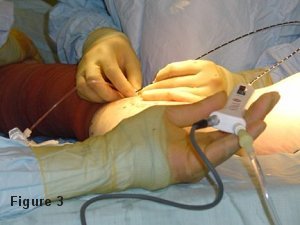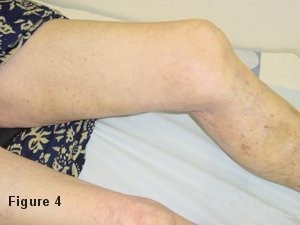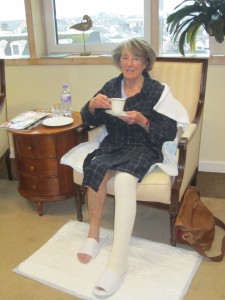VNUS (Radiofrequency) closure of varicose veins
This is the commonest of the keyhole vein procedures we perform, and over a 10 year period we have treated over 5000 patients with it. VNUS closure can usually be performed under local anaesthetic, though sometimes patients prefer to have a small amount of sedation as well. General anaesthesia is only required if the veins are very large or extensive.
A 2mm tube is inserted into the faulty vein under ultrasound control and the vein is internally heated to 120 degrees C by high frequency ultrasound waves (similar to a microwave). This obliterates the vein without having to remove it and only requires a tiny incision and some local anaesthetic so the patient can literally walk out following the treatment. Although there is a little discomfort and stiffness afterwards most patients are able to continue normal activities and drive almost immediately. Long-term follow-up shows that the treated veins remained sealed in over 95% of cases and, in studies where patients have had one leg treated by stripping and the other by radiofrequency, the latter is invariably preferred.
NB If you are having this procedure you should read the section on “postoperative instructions” and “complications following varicose vein surgery”
 |
 |
Laser ablation procedure for keyhole treatment of varicose veins (EVLA)
Lasers are used for a variety of medical conditions from corneal reshaping to cancer destruction. In the EVLA procedure a laser fibre is inserted into the saphenous vein and heats the blood inside to several hundred degrees C. This produces a steam bubble which destroys and closes the vein. Because of the intense energy production, the pain and bruising afterwards is slightly greater when compared to VNUS, so we tend to use the latter.
NB If you are having this procedure you should read the section on “postoperative instructions” and “complications following varicose vein surgery”
Bioadhesive glue (Venaseal)
Tissue glues are often used to close small skin incisions or lacerations but a recent product seems to close abnormal veins too. Under ultrasound control the bioadhesive glue is introduced into the abnormal vein and seals it within 30 days. No local anaesthetic injections are needed and the patients do not require stockings afterwards, so this is probably the most patient-friendly of the keyhole procedures. However, this is a recent innovation so we cannot yet be sure how long the procedure lasts. Mr Ray has performed the most Venaseal procedures inthe UK and will be happy to recommend it for suitable patients.
Excision of small varicose veins
In addition to or instead of the above keyhole procedures it is often worth removing bulging or painful varicose veins by simple “avulsions”. Very small (2-3mm) cuts are made over your varicose veins to remove them. The incisions are closed with surgical tape, which can be removed after 48 hours. It is normal to have bruising or a “lumpy” feeling there afterwards, but this improves over the next 4-6 weeks. The cuts eventually form small scars, the appearance of which may be unpredictable, but are particularly likely to be visible if you have had bad scarring before, or have pale skin.

